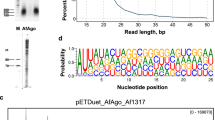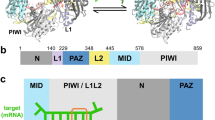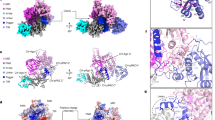Abstract
Here we report on a 3.0 Å crystal structure of a ternary complex of wild-type Thermus thermophilus argonaute bound to a 5′-phosphorylated 21-nucleotide guide DNA and a 20-nucleotide target RNA containing cleavage-preventing mismatches at the 10–11 step. The seed segment (positions 2 to 8) adopts an A-helical-like Watson–Crick paired duplex, with both ends of the guide strand anchored in the complex. An arginine, inserted between guide-strand bases 10 and 11 in the binary complex, locking it in an inactive conformation, is released on ternary complex formation. The nucleic-acid-binding channel between the PAZ- and PIWI-containing lobes of argonaute widens on formation of a more open ternary complex. The relationship of structure to function was established by determining cleavage activity of ternary complexes containing position-dependent base mismatch, bulge and 2′-O-methyl modifications. Consistent with the geometry of the ternary complex, bulges residing in the seed segments of the target, but not the guide strand, were better accommodated and their complexes were catalytically active.
This is a preview of subscription content, access via your institution
Access options
Subscribe to this journal
Receive 51 print issues and online access
$199.00 per year
only $3.90 per issue
Buy this article
- Purchase on Springer Link
- Instant access to full article PDF
Prices may be subject to local taxes which are calculated during checkout




Similar content being viewed by others
Change history
17 February 2008
In the version of this article initially published online, the equation in the Methods section was incorrect. The correct equation is shown. The error has been corrected for all versions of the article.
References
Hock, J. & Meister, G. The Argonaute protein family. Genome Biol. 9, 210 (2008)
Filipowicz, W. The nuts and bolts of the RISC machine. Cell 122, 17–20 (2005)
Hutvagner, G. & Simard, M. J. Argonaute proteins: key players in RNA silencing. Nature Rev. Mol. Cell Biol. 9, 22–32 (2008)
Tolia, N. H. & Joshua-Tor, L. Slicer and the argonautes. Nature Chem. Biol. 3, 36–43 (2007)
Song, J. J., Smith, S. K., Hannon, G. J. & Joshua-Tor, L. Crystal structure of Argonaute and its implications for RISC slicer activity. Science 305, 1434–1437 (2004)
Liu, J. et al. Argonaute2 is the catalytic engine of RNAi. Science 305, 1437–1441 (2004)
Parker, J. S., Roe, S. & Barford, D. Crystal structure of a PIWI protein suggests mechanisms for siRNA recognition and slicer activity. EMBO J. 23, 4727–4737 (2004)
Fire, A. et al. Potent and specific genetic interference by double-stranded RNA in Caenorhabditis elegans . Nature 391, 806–811 (1998)
Elbashir, S. M., Lendeckel, W. & Tuschl, T. RNA interference is mediated by 21- and 22-nucleotide RNAs. Genes Dev. 15, 188–200 (2001)
Martinez, J. & Tuschl, T. RISC is a 5′-phosphomonoester-producing RNA endonuclease. Genes Dev. 18, 975–980 (2004)
Schwarz, D. S., Tomari, Y. & Zamore, P. D. The RNA-induced silencing complex is a Mg2+-dependent endonuclease. Curr. Biol. 14, 787–791 (2004)
Tomari, Y. & Zamore, P. D. Perspective: machines for RNAi. Genes Dev. 19, 517–529 (2005)
De Fougerolles, A., Vornlocher, H.-P., Maraganore, J. & Lieberman, J. Interfering with disease: a progress report on siRNA-based therapeutics. Nature Rev. Drug. Discovery 6, 443–453 (2007)
Kim, D. H. & Rossi, J. J. Strategies for silencing human disease using RNA interference. Nature Rev. Genetics 8, 173–184 (2007)
Filipowicz, W., Jaskiewicz, L., Kolb, F. A. & Pillai, R. S. Post-transcriptional gene silencing by siRNAs and miRNAs. Curr. Opin. Struct. Biol. 15, 331–341 (2005)
Hall, T. M. Structure and function of argonaute proteins. Structure 13, 1403–1408 (2005)
Parker, J. S. & Barford, D. Argonaute: a scaffold for the function of short regulatory RNAs. Trends Biochem. Sci. 31, 622–630 (2006)
Patel, D. J. et al. Structural biology of RNA silencing and its functional implications. Cold Spring Harb. Symp. Quant. Biol. 71, 81–93 (2006)
Yuan, Y. R. et al. Crystal structure of A. aeolicus argonaute, a site-specific DNA-guided endoribonuclease, provides insights into RISC-mediated mRNA cleavage. Mol. Cell 19, 405–419 (2005)
Wang, Y. et al. Structure of the guide-strand-containing Argonaute silencing complex. Nature 456, 209–213 (2008)
Parker, J. S., Roe, S. M. & Barford, D. Structural insights into mRNA recognition from a PIWI domain-siRNA guide complex. Nature 434, 663–666 (2005)
Ma, J. B. et al. Structural basis for 5′-end-specific recognition of guide RNA by the A. fulgidus Piwi protein. Nature 434, 666–670 (2005)
Ma, J. B., Ye, K. & Patel, D. J. Structural basis for overhang-specific small interfering RNA recognition by the Paz domain. Nature 429, 318–322 (2004)
Lingel, A., Simon, B., Izaurralde, E. & Sattler, M. Nucleic acid 3′-end recognition by the Argonaute2 Paz domain. Nature Struct. Mol. Biol. 11, 576–577 (2004)
Haley, B. & Zamore, P. D. Kinetic analysis of the RNAi enzyme complex. Nature Struct. Mol. Biol. 11, 599–606 (2004)
Nowotny, M., Gaidamakov, S. A., Crouch, R. J. & Yang, W. Crystal structures of RNase H bound to an RNA/DNA hybrid: substrate specificity and metal-dependent catalysis. Cell 121, 1005–1016 (2005)
Schwarz, D. S. et al. Asymmetry in the assembly of the RNAi enzyme complex. Cell 115, 199–208 (2003)
Chen, P. Y. et al. Strand-specific 5′-O-methylation of siRNA duplexes controls guide strand selection and targeting specificity. RNA 14, 263–274 (2008)
Jackson, A. L. et al. Position-specific chemical modification of siRNAs reduces “off-target” transcript silencing. RNA 12, 1197–1205 (2006)
Dorsett, Y. & Tuschl, T. siRNAs: applications in functional genomics and potential as therapeutics. Nature Rev. Drug Discov. 3, 318–329 (2004)
Jackson, A. L. et al. Expression profiling reveals off-target gene regulation by RNAi. Nature Biotechnol. 21, 635–637 (2003)
Gunawardane, L. S. et al. A slicer-mediated mechanism for repeat-associated siRNA 5′-end formation in Drosophila . Science 315, 1587–1590 (2007)
Martinez, J. et al. Single-stranded anti-sense siRNAs guide target RNA cleavage in RNAi. Cell 110, 563–574 (2002)
MacRae, I. J. et al. In vitro reconstitution of human RISC-loading complex. Proc. Natl Acad. Sci. USA 105, 512–517 (2008)
Ameres, S. L., Martinez, J. & Schroeder, R. Molecular basis for target RNA recognition and cleavage by human RISC. Cell 130, 101–112 (2007)
Rana, T. M. Illuminating the silence: understanding the structure and function of small RNAs. Nature Rev. Mol. Cell Biol. 8, 23–26 (2007)
Otwinowski, Z. & Minor, W. Processing of X-ray diffraction data collected in oscillation mode. Meth. Enzymol. 276, 307–326 (1997)
McCoy, A. J. et al. Phaser crystallographic software. J. App. Crystallogr. 40, 658–674 (2007)
Brunger, A. T. et al. Crystallography & NMR system: A new software suite for macromolecular structure determination. Acta Crystallogr. D 54, 905–921 (1998)
Emsley, P. & Cowtan, K. Coot: model-building tools for molecular graphics. Acta Crystallogr. D 60, 2126–2132 (2004)
Jones, T. A., Zhou, J. Y., Cowan, S. W. & Kjeldgaard, M. Improved methods for building protein models in electron density maps and the location of errors in these models. Acta Crystallogr. A 47, 110–119 (1991)
Acknowledgements
The research was supported by funds from the National Institutes of Health and the Starr Foundation to D.J.P. and T.T. We would like to thank the staff of NE-CAT beam line at the Advanced Photon Source, Argonne National Laboratory, supported by the US Department of Energy, for assistance with data collection.
Author Contributions Y.W. and G.S. expressed and purified T. thermophilus Ago, and grew crystals of the ternary complex. H.L. and Y.W. collected X-ray diffraction data on the micro-focus beam line, and Y.W. solved the structure of the ternary complex. The structural studies were undertaken with the supervision of D.J.P. S.J. was responsible for the cleavage assays on Ago with modified guide strands under the supervision of T.T. D.J.P. and T.T. were primarily responsible for writing the paper and all authors read and approved the submitted manuscript.
Author information
Authors and Affiliations
Corresponding authors
Supplementary information
Supplementary Information
This file contains Supplementary Tables 1-3 and Supplementary Figures 1-14 with Legends. (PDF 7679 kb)
Supplementary Movie 1
Supplementary Movie 1 shows the Ago ternary complex structure and the conformational transitions on proceeding from the binary to the ternary complex. (AVI 15949 kb)
Supplementary Movie 2
Supplementary Movie 2 shows the Ago ternary complex structure and the conformational transitions on proceeding from the binary to the ternary complex. (AVI 2923 kb)
Supplementary Movie 3
Supplementary Movie 3 shows the Ago ternary complex structure and the conformational transitions on proceeding from the binary to the ternary complex. (AVI 24460 kb)
Rights and permissions
About this article
Cite this article
Wang, Y., Juranek, S., Li, H. et al. Structure of an argonaute silencing complex with a seed-containing guide DNA and target RNA duplex. Nature 456, 921–926 (2008). https://doi.org/10.1038/nature07666
Received:
Accepted:
Issue Date:
DOI: https://doi.org/10.1038/nature07666
This article is cited by
-
Structural basis of antiphage immunity generated by a prokaryotic Argonaute-associated SPARSA system
Nature Communications (2024)
-
Cryo-EM structure and protease activity of the type III-E CRISPR-Cas effector
Nature Microbiology (2023)
-
microRNAs in action: biogenesis, function and regulation
Nature Reviews Genetics (2023)
-
Emerging roles and functional mechanisms of PIWI-interacting RNAs
Nature Reviews Molecular Cell Biology (2023)
-
RNA-based disease control of citrus canker caused by Xanthomonas: challenges and perspectives
Journal of Plant Diseases and Protection (2023)
Comments
By submitting a comment you agree to abide by our Terms and Community Guidelines. If you find something abusive or that does not comply with our terms or guidelines please flag it as inappropriate.



